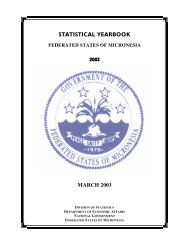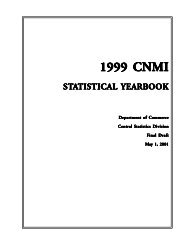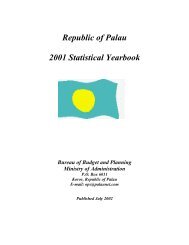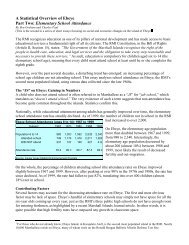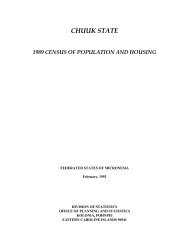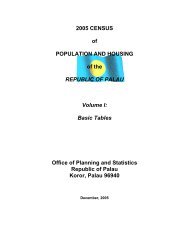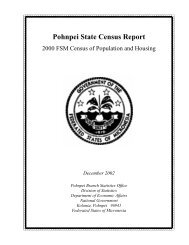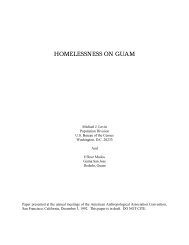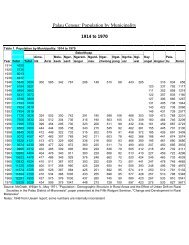Chuuk State Census Report - pacificweb.org
Chuuk State Census Report - pacificweb.org
Chuuk State Census Report - pacificweb.org
You also want an ePaper? Increase the reach of your titles
YUMPU automatically turns print PDFs into web optimized ePapers that Google loves.
2000 FSM <strong>Census</strong> of <strong>Chuuk</strong> <strong>State</strong>Chapter 8. Education2000 census results show that more females were being enrolled at the secondary and tertiary levels of education,probably indicating improvement in female education in these two particular educational levels.Table 8.2: School Attendance for Age 3 Years and Over by Level and Type, <strong>Chuuk</strong> <strong>State</strong>: 1994 and 20001994 2000Number Percent Males per Number Percent Males perLevel and Type Total Males Females Females 100 females Total Males Females females 100 femalesTotal enrollment 17,601 9,058 8,543 48.5 106.0 17,082 8,559 8,523 49.9 100.4Pre-school/kindergarten 960 508 452 47.1 112.4 823 416 407 49.5 102.2Public 831 449 382 46.0 117.5 722 371 351 48.6 105.7Private 129 59 70 54.3 84.3 101 45 56 55.4 80.4Elementary 11,645 6,079 5,566 47.8 109.2 10,992 5,678 5,314 48.3 106.8Public 10,650 5,616 5,034 47.3 111.6 10,245 5,316 4,929 48.1 107.9Private 995 463 532 53.5 87.0 747 362 385 51.5 94.0High school 4,380 2,139 2,241 51.2 95.4 4,573 2,139 2,434 53.2 87.9Public 3,741 1,819 1,922 51.4 94.6 4,091 1,913 2,178 53.2 87.8Private 639 320 319 49.9 100.3 482 226 256 53.1 88.3College 616 332 284 46.1 116.9 694 326 368 53.0 88.6Source: 1994 FSM <strong>Census</strong>, Table P24; 2000 FSM <strong>Census</strong>, Table P2-12.School Attendance by Age and SexOne way to analyze the coverage of the school system and the extent of dropouts is to look at the proportion enrolled(or enrollment rates) at each age, among the school age population. Enrollment rate is defined as number of studentsenrolled at a given age per 100 population of that age. Table 8.3 and Figure 8.1 show that enrollment reached amaximum between the ages of 9 and 10 years in 1994 and age 10 in 2000. As shown, enrollment started to declinesignificantly at the ages of 15 in 1994 and 16 in 2000. These specific ages, 15 and 16, are usually when one graduatedfrom junior high school or just entered high school. The decline of enrollment at these ages signals an increasing rateof dropouts after the junior high school level, which may be due in part to the failure to pass the high school entrancetest. Even at ages where school attendance was highest, about 10 percent of the school age population remained outsidethe school system in 2000. The overall enrollment of the school age population was about 56 in 2000 (similar to that in1994). This is the second lowest enrollment rate in the FSM (2000 National <strong>Census</strong> <strong>Report</strong>, Table 8.4). Age-specificenrollment rates between the ages of 14 to 18 years were slightly higher for females most likely due to higher dropoutrate for males, after the elementary level of education (see Tables 8.2, 8.3 and Figure 8.2).Table 8.3: Age-specific Enrollment Ratio per 100 by Age and Sex, <strong>Chuuk</strong> <strong>State</strong>: 1994 and 20001994 <strong>Census</strong> 2000 <strong>Census</strong>Enrollment by Age Enrollment by Sex Enrollment by Age Enrollment by SexAge Total Males Females Total Males Females Total Males Females Total Males FemalesTotal 56.3 55.9 56.7 100.0 51.6 48.4 56.4 54.8 58.1 100.0 50.4 49.63 4.3 4.2 4.4 100.0 50.0 50.0 8.3 7.7 9.0 100.0 47.4 52.64 21.5 22.7 20.0 100.0 56.3 43.7 27.5 26.0 28.9 100.0 48.4 51.65 57.3 56.7 57.9 100.0 50.5 49.5 60.9 60.2 61.6 100.0 51.5 48.56 75.0 73.7 76.4 100.0 51.6 48.4 80.5 79.5 81.4 100.0 48.7 51.37 80.7 80.4 81.1 100.0 55.6 44.4 86.7 87.1 86.2 100.0 52.0 48.08 83.1 82.4 83.9 100.0 51.9 48.1 88.0 87.4 88.6 100.0 51.7 48.39 86.1 86.2 86.0 100.0 51.9 48.1 87.0 86.4 87.6 100.0 50.3 49.710 85.2 84.5 86.0 100.0 52.9 47.1 88.9 87.0 91.1 100.0 54.0 46.011 84.9 84.0 85.8 100.0 51.8 48.2 87.0 85.2 88.9 100.0 50.6 49.412 83.8 82.8 84.8 100.0 51.2 48.8 84.6 82.9 86.6 100.0 51.5 48.513 81.1 81.0 81.3 100.0 48.0 52.0 84.0 82.6 85.7 100.0 53.6 46.414 76.7 75.0 78.4 100.0 49.4 50.6 76.3 73.7 79.1 100.0 49.4 50.615 70.5 69.6 71.5 100.0 50.7 49.3 71.4 66.4 77.0 100.0 49.1 50.916 59.0 55.4 63.0 100.0 49.5 50.5 60.3 55.0 65.9 100.0 46.6 53.417 47.5 48.0 47.0 100.0 54.9 45.1 44.4 41.4 47.3 100.0 46.3 53.718 36.1 34.2 38.3 100.0 50.9 49.1 34.1 32.3 35.8 100.0 46.8 53.219 28.3 28.5 28.1 100.0 52.9 47.1 24.3 21.2 27.4 100.0 43.6 56.420 20.2 18.9 21.5 100.0 45.9 54.1 16.4 15.4 17.6 100.0 48.6 51.421 18.2 17.8 18.6 100.0 47.3 52.7 12.7 12.6 12.7 100.0 48.8 51.222 15.4 16.0 14.9 100.0 52.6 47.4 9.7 9.4 10.2 100.0 55.6 44.423 13.4 13.4 13.4 100.0 52.8 47.2 8.2 8.1 8.3 100.0 54.1 45.924 11.1 13.3 8.9 100.0 60.6 39.4 7.6 7.2 8.0 100.0 50.0 50.0Source: 1994 & 2000 FSM <strong>Census</strong>es, unpublished data<strong>Chuuk</strong> Branch Statistics Office, Division of Statistics, FSM Department of Economic Affairs 65



